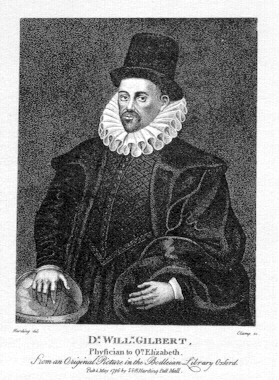William Gilbert
Today, the magnet draws science into a new era. The University of Houston's College of Engineering presents this series about the machines that make our civilization run, and the people whose ingenuity created them.
In the Gilbert-and-Sullivan operetta Patience, William Gilbert likens failed love to the wrong use of a magnet. He says,
While this magnetic
Peripatetic
Lover, he lived to learn,
By no endeavor,
Can magnet ever
Attract a Silver Churn!
Now I read a book by another William Gilbert. It was published long before -- in 1600. The title is De Magnete It's the first great treatise on magnetism. It's also England's first bid for a place in the new science that rose from the Renaissance.
This Gilbert uses similar imagery. He says,
Orpheus, in his hymns, tells that iron is drawn by the loadstone as the bride to the embraces of her spouse.
He also uses the word "coition" for magnetic attraction.
Gilbert was now 56. He was a distinguished doctor in Queen Elizabeth's court. Elizabeth was a solid patroness of science. She treated Gilbert well, and he honored her. He never married, and he gave up his own ghost just months after her death in 1603.
De Magnete is a powerful work. Gilbert honed the new logic of experimental reasoning. Francis Bacon usually gets credit for that, but he wrote 20 years later. Gilbert turned away from the old language and methods of the alchemists.
The alchemists didn't like Gilbert one bit. But a pious young Johannes Kepler had been asking how the Holy Ghost went about moving the planets. He saw his answer in Gilbert. Planets must exert magnetic forces on each other. Gilbert had led Kepler half way to Newton's gravitational theory.
Galileo also read De Magnete. He said, "I extremely praise, admire, and envy [Gilbert.]" Galileo wasn't often that kind about another scientist.
So we turn pages in De Magnete. We find astonishing vision for that age. Gilbert distinguishes between magnetic and electric fields. He ties lodestones to the earth's magnetic field. He has a lot to say about compasses. And, of course, he confirms what the 19th-century Gilbert said about love. A magnet cannot draw silver to it.
A friend of Gilbert's said, "[He had a] happiness not ordinary in so hard a student and retired a person." Well, you and I recognize that happiness by now. Gilbert had the cheerful serenity that marks people with the insight to look at the world -- and see it as it really is.
I'm John Lienhard, at the University of Houston, where we're interested in the way inventive minds work.
(Theme music)
Gilbert, W., de Magnete. (tr. by P. Fleury Mottelay) New York: Dover Publications, Inc., 1958. (republication of the 1893 translation.)
Roller, D.H.D., The de Magnete of William Gilbert. Amsterdam: Menno Hertzberger, 1959.
Debus, A.G., The English Paracelsians. New York: Franklin Watts, Inc., 1966.
Boorstin, D.J., The Discoverers. New York: Random House, 1983, Chapter 39.

Image courtesy of the Burndy Library, Dibner Institute for the History of Science and Technology
William Gilbert